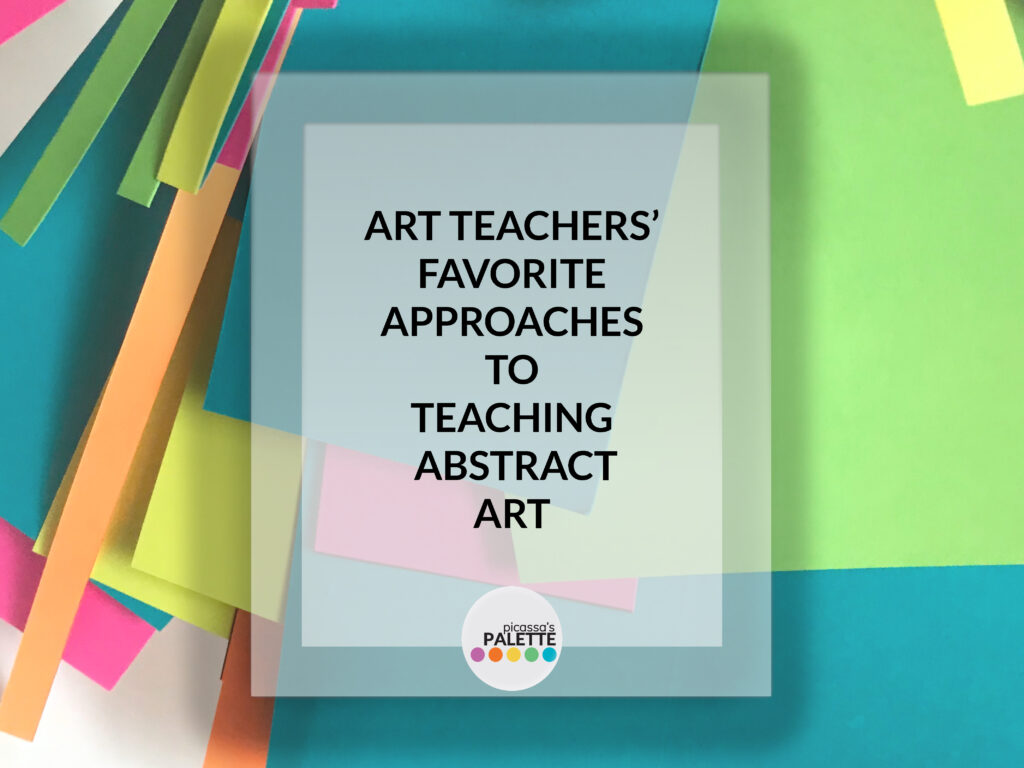
Abstract art, with its emphasis on freedom of expression and creativity, holds a special place in the world of art education. Unlike traditional art forms that often require adherence to specific rules and techniques, abstract art gives us art teachers the freedom to encourage our students to explore their emotions, thoughts, and perceptions in a visually expressive way.
Embracing the Freedom of Abstract Art
One of my favorite aspects of teaching abstract art is that it can strongly encourage students to let go of their fear of making mistakes. When there is no ‘visual comparison’, I find that students have nothing to measure their work against. Comparison is one enemy to an individual’s capacity for expression.
Planning and Preparing for Abstract Art
There are SO many ways to approach the process for planning and preparing abstract art projects. I’ve shared a few of my favorite ideas for planning Abstract Art lessons here on this post– including a ‘guiding formula’ I use to come up with abstract art projects…
I’ve talked a little about my classroom “must-have” for abstract art material prep and shared some tips and tricks for 2D Mixed Media collage, using abstract art ideas to fill visual journaling pages and altered books.
But when it comes to teaching Abstract Art in standalone projects, many teachers love the convenience of having those ready-made lessons and plans already on-hand.
Luckily, a few of us art teachers have invested our time and talent into creating completed abstract art lessons and project examples and offering them to you and your budding artists…
Inspiring Abstract Art … Featuring Art Teachers’ Favorite Projects
On that note, I recently asked some of my fellow art teacher-authors about their favorite ways to teach Abstract Art… and their ideas and approaches were just about as varied as the way our students express themselves through art!
Read below to check out what they said!
…
Stacey from Expressive Monkey:
Abstract Art Ideas with The Element of Chance
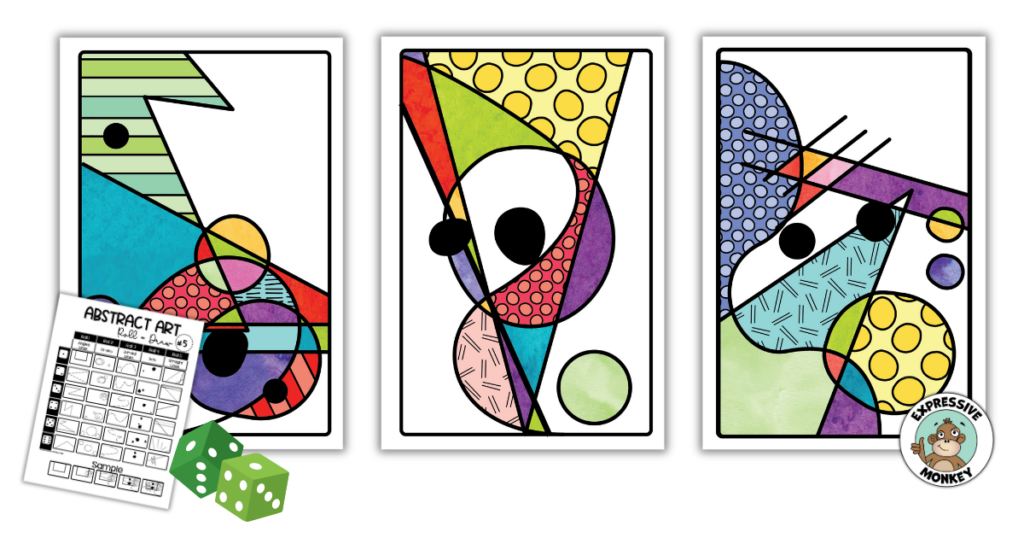
Hi this is Stacey from Expressive Monkey! I love incorporating the element of chance into my lessons, including making abstract art.
Adding a bit of chance to your abstract art is like letting go of the steering wheel and seeing where the ride takes you. While I don’t recommend driving a car that way, letting chance guide your abstract art adds an unexpected twist and helps you create something you never saw coming.
Instead of mapping out every detail, you let randomness take over—whether you’re spinning a color wheel, splattering paint in unexpected ways, or rolling dice to figure out what to add next. It’s a fun way to break free from routine and invite happy accidents into your creative process. You’ll end up with something totally unique and probably way cooler than you planned.
This approach mirrors how things unfold in nature—nothing’s perfectly organized, but everything just works. Think about how leaves fall or how clouds drift without any particular design, and that’s the kind of freedom chance brings to your work. Plus, it’s a great way to break out of creative ruts and stop overthinking.
One of my favorite ways to use the element of chance is rolling the dice. This is an easy and fun way to try this out with students. Using my Abstract Art Roll & Draw, with each roll, you’ll pick out an element to add to your abstract drawing. From lines and shapes to textures and patterns, each work of art will be unique!
Using the element of chance is a playful way to explore abstract art, and who knows? The next surprise element you add might just be the most exciting part of your piece!
You can read more from Expressive Monkey in these blog posts:
Abstract Art Ideas with The Element of Chance & Drawing with the Element of Chance
If you are interested in trying out more of Expressive Monkey’s art lessons, you can find them here.
Whitney from Look Between The Lines:
Breaking Down Abstract Art
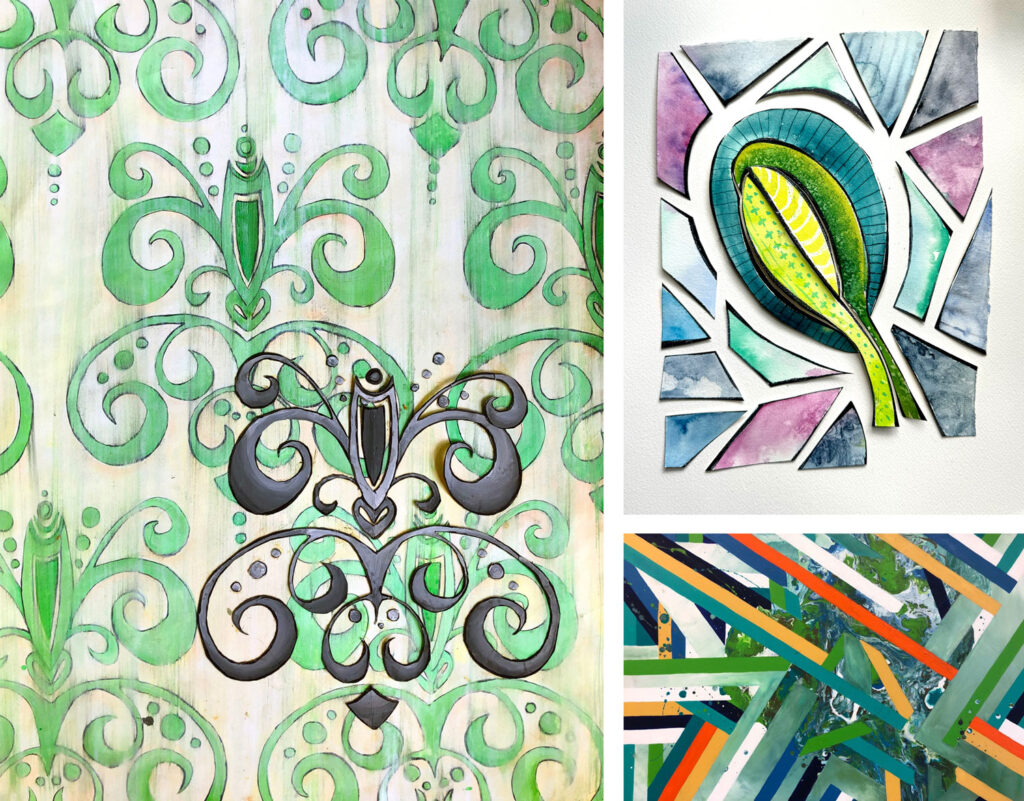
Abstract art may seem simple, but it’s one of the most difficult concepts to teach students how to create successfully. It’s easy to miss striking a balance, creating a focal point, and interest when you have only the basics to work with. Despite this, I have found by focusing on line, shape, and color individually, and showing artist exemplars and good examples, students can grasp abstract art.
Abstract art in elementary: I begin teaching abstract art in fourth grade. My favorite way to introduce it is through a focus on shape. Students create a design using either organic or geometric shapes. They fill the spaces with different watercolor techniques, cut up their design, and then glue it down to create a final abstract design. This project is a great introduction lesson through 9th grade. Check out project examples and hit the easy button by grabbing my lesson pack here.
Abstract art in middle school: In upper middle school, advanced middle school art, and high school art classes I like to teach abstract art by first basing it in reality. Students start with an object that reflects a memory. They then go through multiple sketches simplifying that object until it’s almost unrecognizable. They cut a template, trace it on watercolor paper, then fill it with paint that ties into a color scheme. This is a fun way to bring meaning and abstraction into one work of art. Read all the details in a blog post on this lesson here.
Abstract art in high school: One of my all-time favorite high school projects is a large-scale abstract painting. I teach this to my advanced-level high school art students, which typically means I have less students in a class and we can get BIG canvases to work on. For this project, we are focusing on either line, shape, or color as the primary subject. This work of art should be purely abstract, it shouldn’t resemble anything. While line, shape, and color will be incorporated in every work of art, one of these elements should stand out most. Read more and see examples in a blog post here.
Check out more elementary through high school art projects on my website and TPT shop!
From Melissa of The Speckled Sink:
Abstract for All Ages with Paul Klee
When it comes to introducing children to the world of abstract art, Paul Klee provides a solid start. His unique style, vibrant colors, and whimsical forms make him an ideal figure for learners.
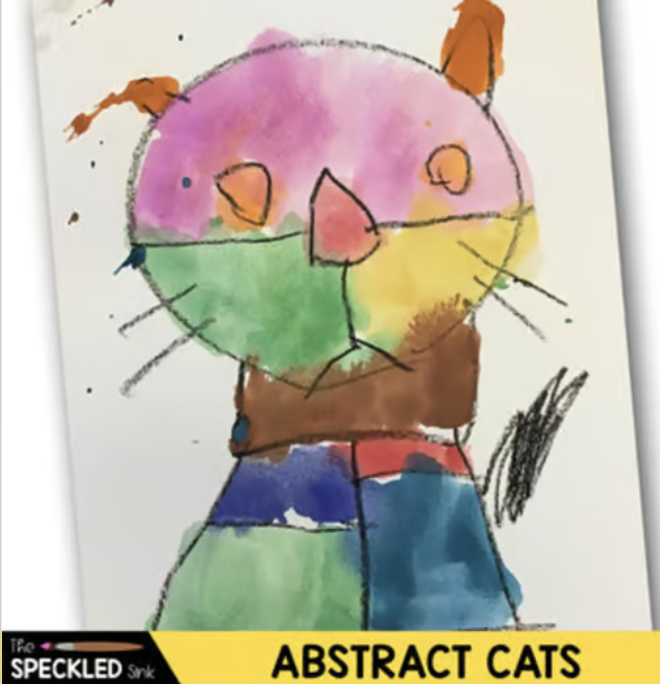
Elementary students really enjoy creating works inspired by his “Castle and Sun” painting as well as “Cat and Bird.” Pairing his work next to photographs of similar items is a great way to introduce the concept of abstraction.
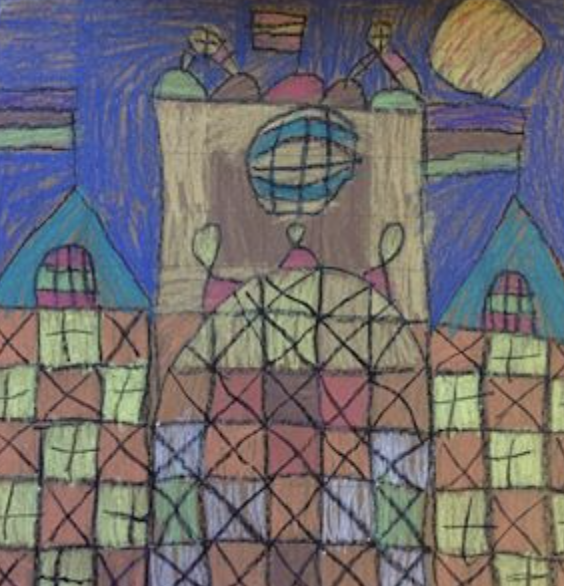
Students of all ages are extremely motivated to create their own hidden messages artworks inspired by “Once Emerged from the Gray of Night.”
At the elementary level, students can create messages of gratitude or poems inspired by the seasons that also connect to warm and cool color palettes.
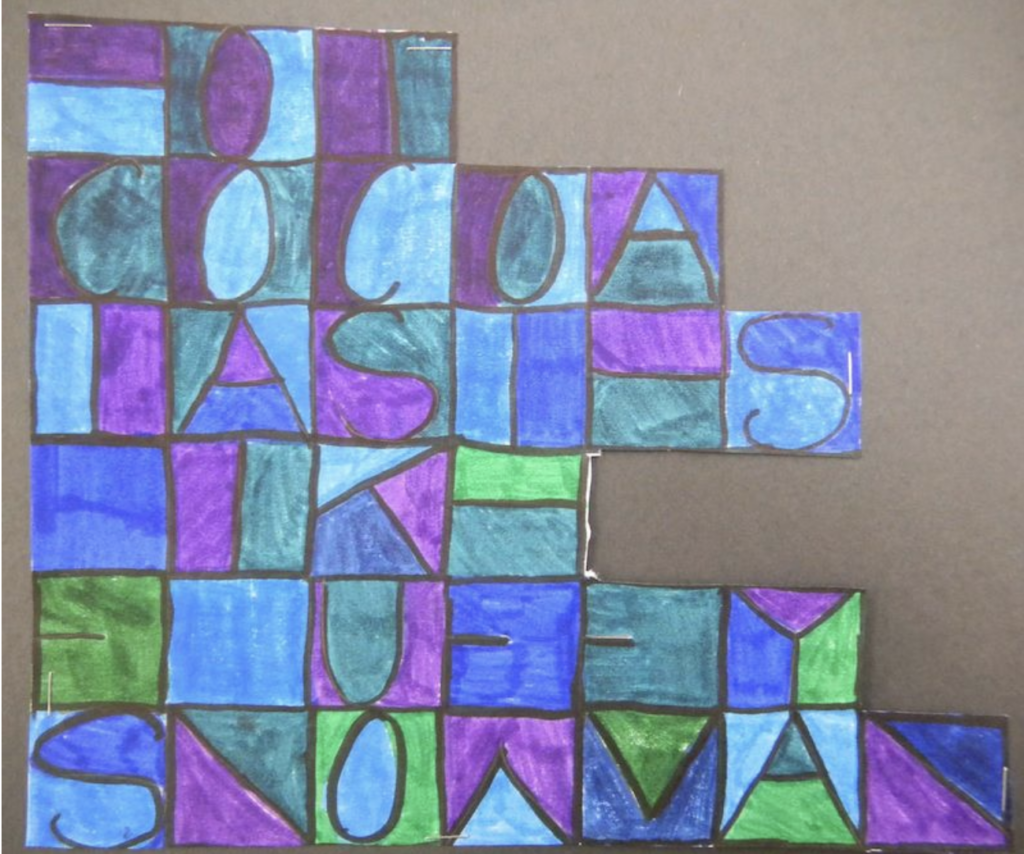
My secondary students love to hide their favorite lyrics inside a grid while practicing their hand-eye control and painting water color washes using a chosen color scheme.
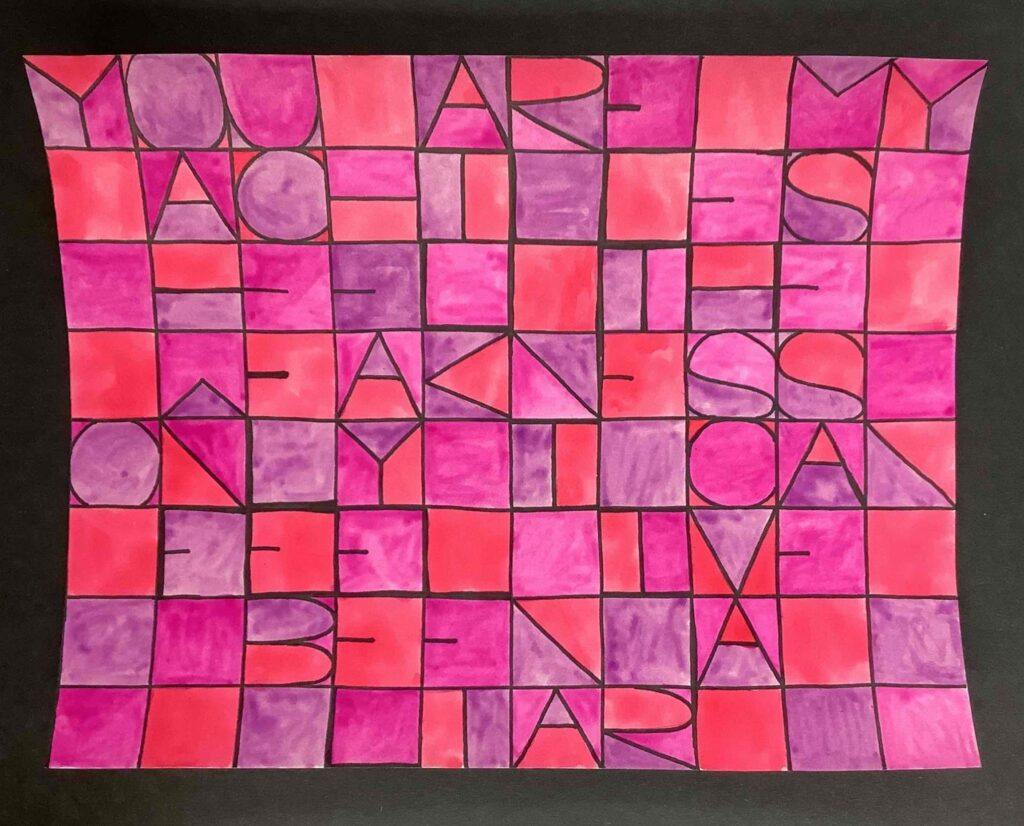
Whether your primary objective is providing accessible techniques or providing a springboard for conversation about modern art, you can’t go wrong with Paul Klee.
You can find more from Melissa on her Instagram and Blog
From Amie of Glitter Meets Glue:
Continuous Line Drawings for Abstract Art Projects
I love using continuous line drawings as a starting point for abstract art projects. My middle schoolers are often apprehensive about abstract art, unsure of how to get started or how to develop their ideas. By using a continuous line drawing as the foundation, they’re encouraged to focus on the process, not the product.
We start by doing a series of drawings to loosen up and brainstorm ideas for the final design. From there, we look to see what shapes are formed from the overlapping lines. And then we can build on the original idea to rough out our first sketch. It’s a lot of adding, subtracting, and modifying, but it works.
This continuous line technique not only helps students break out of their fear of abstraction, but also teaches them to trust the process and their own creativity. It’s an effective way to engage students in deeper, more reflective thinking. It’s why use this concept into my Enrique Pichardo art project. You can check out more details about the project on my website, Glitter Meets Glue!

From Lauren of Inside Out Art Teacher
How To: Teach Abstract Art

Abstract art allows students to explore design and self-expression without worrying about making something “realistic.” It removes the pressure of perfection and will enable them to focus on compositional skills and the elements of art in a playful and engaging way.
If you’re looking for an approachable way to teach abstract art, I’ve got three go-to lessons that have been a hit in my classroom. Whether you’re working with middle or high school students, these projects will help students develop key compositional skills while allowing their creativity to shine.
First, the Neurographic Art Lesson is perfect for teaching balance and repetition. Students focus on repeating shapes and lines with just enough variation to keep things fresh. It’s simple, engaging, and a great way to introduce balance without overwhelming students with complex techniques.
Next, the Neurographic Art Composition Project builds on everything they’ve learned about shape, line, and color and adds the element of mood. This lesson dives into how colors can affect the overall feel of their composition and is perfect for students ready to explore more profound creative expression.
Finally, the Abstract Acrylic Painting Lesson pushes students to think about color and contrast while repeating shapes across their canvas. It’s fantastic for beginners because it starts simple but encourages them to explore balance, contrast, and color variation—all in a fun, creative way.
Want to explore these lessons in more detail and get step-by-step guides? Check out my full blog post, where I break down each lesson, offer classroom tips, and provide ready-to-use lesson plans. Your students will love these projects, and you’ll love how easy they are to implement!
More exciting middle and high school art lessons can be found on my website or in my TPT shop!
Extending: On Encouraging Reflection and Discussion Upon Abstract Art Projects
An essential part of teaching abstract art is encouraging students to reflect on their artwork and engage in discussions about it. No matter which project or lesson you choose to teach your students about Abstract Art, reflecting upon their artwork can help them articulate their thoughts and learn from each other- it’s a solidifying component of the learning process.
The Possibilities Are Endless…
Abstract art truly offers endless possibilities for creativity and self-expression. By embracing the freedom it provides, teachers can inspire their students to explore new ideas, experiment with different techniques, and ultimately develop their unique artistic voices.
… And with the help of prepared resources like the ones above, approaching those endless possibilities and narrowing them down in order to help your developing artists doesn’t have to be an overwhelming choice.
The projects, lessons and approaches shared by these knowledgeable art educators demonstrate the power of abstract art in helping students connect with and express their inner selves and the convenience available to you as you facilitate learning through creativity and expression.
Whether through expression of inner emotion, interpretation of a concept, or exploration through a given media, creating abstract art continues to be a valuable aspect of providing your students with a boundless art education.
So… what are your favorite abstract art teaching techniques or projects? Have you used some of the resources above? I’d love to know! Share your experiences by tagging @picassaspalette on social media!